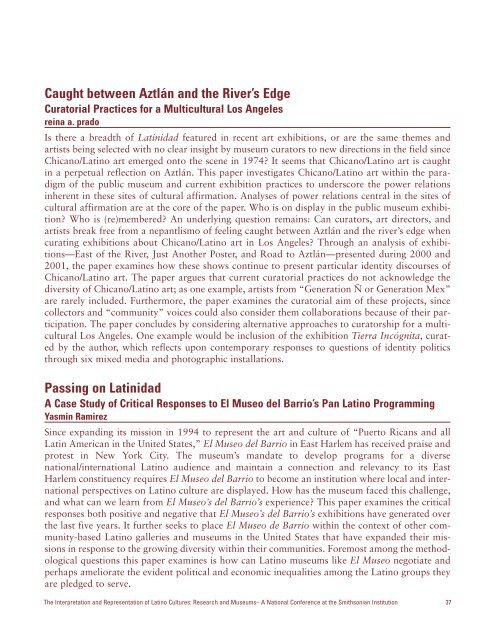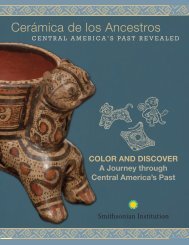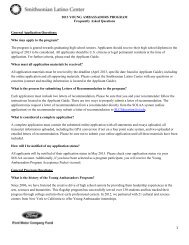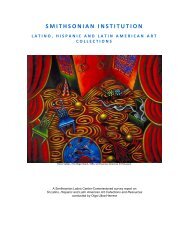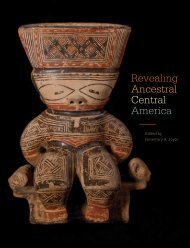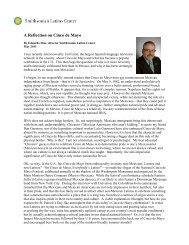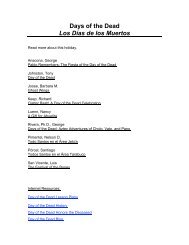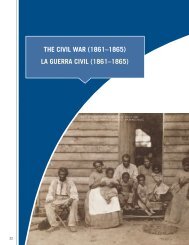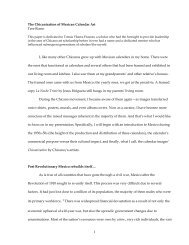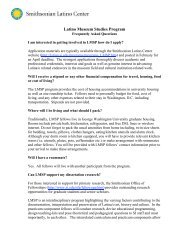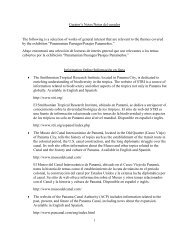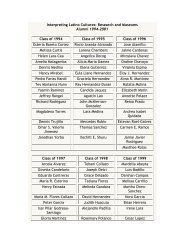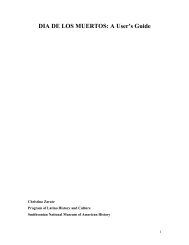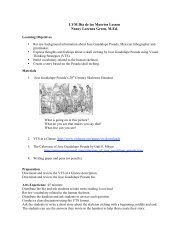Research and Museums - Smithsonian Latino Center - Smithsonian ...
Research and Museums - Smithsonian Latino Center - Smithsonian ...
Research and Museums - Smithsonian Latino Center - Smithsonian ...
Create successful ePaper yourself
Turn your PDF publications into a flip-book with our unique Google optimized e-Paper software.
Caught between Aztlán <strong>and</strong> the River’s EdgeCuratorial Practices for a Multicultural Los Angelesreina a. pradoIs there a breadth of Latinidad featured in recent art exhibitions, or are the same themes <strong>and</strong>artists being selected with no clear insight by museum curators to new directions in the field sinceChicano/<strong>Latino</strong> art emerged onto the scene in 1974? It seems that Chicano/<strong>Latino</strong> art is caughtin a perpetual reflection on Aztlán. This paper investigates Chicano/<strong>Latino</strong> art within the paradigmof the public museum <strong>and</strong> current exhibition practices to underscore the power relationsinherent in these sites of cultural affirmation. Analyses of power relations central in the sites ofcultural affirmation are at the core of the paper. Who is on display in the public museum exhibition?Who is (re)membered? An underlying question remains: Can curators, art directors, <strong>and</strong>artists break free from a nepantlismo of feeling caught between Aztlán <strong>and</strong> the river’s edge whencurating exhibitions about Chicano/<strong>Latino</strong> art in Los Angeles? Through an analysis of exhibitions—Eastof the River, Just Another Poster, <strong>and</strong> Road to Aztlán—presented during 2000 <strong>and</strong>2001, the paper examines how these shows continue to present particular identity discourses ofChicano/<strong>Latino</strong> art. The paper argues that current curatorial practices do not acknowledge thediversity of Chicano/<strong>Latino</strong> art; as one example, artists from “Generation Ñ or Generation Mex”are rarely included. Furthermore, the paper examines the curatorial aim of these projects, sincecollectors <strong>and</strong> “community” voices could also consider them collaborations because of their participation.The paper concludes by considering alternative approaches to curatorship for a multiculturalLos Angeles. One example would be inclusion of the exhibition Tierra Incógnita, curatedby the author, which reflects upon contemporary responses to questions of identity politicsthrough six mixed media <strong>and</strong> photographic installations.Passing on LatinidadA Case Study of Critical Responses to El Museo del Barrio’s Pan <strong>Latino</strong> ProgrammingYasmin RamirezSince exp<strong>and</strong>ing its mission in 1994 to represent the art <strong>and</strong> culture of “Puerto Ricans <strong>and</strong> allLatin American in the United States,” El Museo del Barrio in East Harlem has received praise <strong>and</strong>protest in New York City. The museum’s m<strong>and</strong>ate to develop programs for a diversenational/international <strong>Latino</strong> audience <strong>and</strong> maintain a connection <strong>and</strong> relevancy to its EastHarlem constituency requires El Museo del Barrio to become an institution where local <strong>and</strong> internationalperspectives on <strong>Latino</strong> culture are displayed. How has the museum faced this challenge,<strong>and</strong> what can we learn from El Museo’s del Barrio’s experience? This paper examines the criticalresponses both positive <strong>and</strong> negative that El Museo’s del Barrio’s exhibitions have generated overthe last five years. It further seeks to place El Museo de Barrio within the context of other community-based<strong>Latino</strong> galleries <strong>and</strong> museums in the United States that have exp<strong>and</strong>ed their missionsin response to the growing diversity within their communities. Foremost among the methodologicalquestions this paper examines is how can <strong>Latino</strong> museums like El Museo negotiate <strong>and</strong>perhaps ameliorate the evident political <strong>and</strong> economic inequalities among the <strong>Latino</strong> groups theyare pledged to serve.The Interpretation <strong>and</strong> Representation of <strong>Latino</strong> Cultures: <strong>Research</strong> <strong>and</strong> <strong>Museums</strong>– A National Conference at the <strong>Smithsonian</strong> Institution 37


